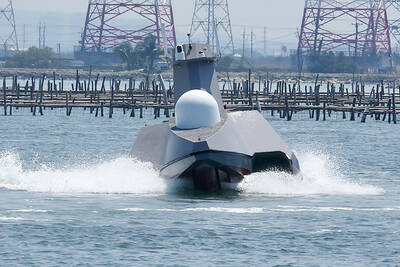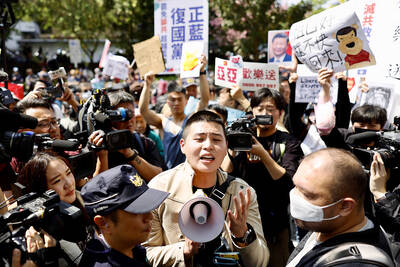Japan yesterday put its nuclear calamity on a par with the world’s worst nuclear disaster, Chernobyl, after new data showed that more radiation leaked from its earthquake-crippled power plant in the early days of the crisis than first thought.
Japanese officials said it had taken time to measure radiation from the plant after it was smashed by March 11’s massive earthquake and tsunami, and the upgrade in its severity rating to the highest level on a globally recognized scale did not mean the situation had suddenly become more critical.
“The situation at the Fukushima Dai-ichi plant is slowly stabilizing, step by step, and the emission of radioactive substances is on a declining trend,” Japanese Prime Minister Naoto Kan told a press briefing.
Kan said he wanted to move from emergency response to long-term rebuilding.
“A month has passed. We need to take steps towards restoration and reconstruction,” he said.
He also called on opposition parties, whose help he needs to pass bills in a divided parliament, to take part in drafting reconstruction plans from an early stage.
The operator of the stricken facility appears to be no closer to restoring cooling systems at the reactors, critical to lowering the temperature of overheated nuclear fuel rods. Late yesterday, Japan’s science ministry said small amounts of strontium, one of the most harmful and long-lasting radioactive elements, had been found in soil near Fukushima Dai-ichi.
Hidehiko Nishiyama, a deputy director-general of the Nuclear and Industrial Safety Agency (NISA), said the decision to raise the severity of the incident from level 5 to 7 — the same as the Chernobyl disaster in Ukraine in 1986 — was based on cumulative quantities of radiation released.
No radiation-linked deaths have been reported since the earthquake struck, and only 21 plant workers have been affected by minor radiation sickness, Chief Cabinet Secretary Yukio Edano said.
“Although the level has been raised to 7 today, it doesn’t mean the situation today is worse than it was yesterday. It means the event as a whole is worse than previously thought,” said nuclear expert John Price, a former member of the Safety Policy Unit at the UK’s National Nuclear Corp.
A level 7 incident means a major release of radiation with a widespread health and environmental impact, while a level 5 is a limited release of radioactive material, with several deaths, according to the International Atomic Energy Agency.
Several experts said the new rating exaggerated the severity of the crisis.
“It’s nowhere near that level. Chernobyl was terrible — it blew and they had no containment, and they were stuck,” said nuclear industry specialist Murray Jennex, an associate professor at San Diego State University in California. “Their containment has been holding, the only thing that hasn’t is the fuel pool that caught fire.”
The blast at Chernobyl blew the roof off a reactor and sent large amounts of radiation wafting across Europe. The accident contaminated vast areas and led to the evacuation of more than 100,000 people.
Nevertheless, the increase in the severity level heightens the risk of diplomatic tension with Japan’s neighbors over radioactive fallout. China has so far been sympathetic rather than angry, though it and South Korea have criticized the plant operator’s decision to pump radioactive water into the sea, a process it has now stopped.
NISA said the amount of radiation released into the atmosphere from the plant was about 10 percent that of Chernobyl.
“Radiation released into the atmosphere peaked from March 15 to 16. Radiation is still being released, but the amount now has fallen considerably,” Nishiyama said.
Lam Ching-wan, a chemical pathologist at the University of Hong Kong and member of the American Board of Toxicology, said this level of radiation was harmful.
“It means there is damage to soil, ecosystem, water, food and people. People receive this radiation. You can’t escape it by just shutting the window,” Lam said.

ENDEAVOR MANTA: The ship is programmed to automatically return to its designated home port and would self-destruct if seized by another party The Endeavor Manta, Taiwan’s first military-specification uncrewed surface vehicle (USV) tailor-made to operate in the Taiwan Strait in a bid to bolster the nation’s asymmetric combat capabilities made its first appearance at Kaohsiung’s Singda Harbor yesterday. Taking inspiration from Ukraine’s navy, which is using USVs to force Russia’s Black Sea fleet to take shelter within its own ports, CSBC Taiwan (台灣國際造船) established a research and development unit on USVs last year, CSBC chairman Huang Cheng-hung (黃正弘) said. With the exception of the satellite guidance system and the outboard motors — which were purchased from foreign companies that were not affiliated with Chinese-funded

PERMIT REVOKED: The influencer at a news conference said the National Immigration Agency was infringing on human rights and persecuting Chinese spouses Chinese influencer “Yaya in Taiwan” (亞亞在台灣) yesterday evening voluntarily left Taiwan, despite saying yesterday morning that she had “no intention” of leaving after her residence permit was revoked over her comments on Taiwan being “unified” with China by military force. The Ministry of the Interior yesterday had said that it could forcibly deport the influencer at midnight, but was considering taking a more flexible approach and beginning procedures this morning. The influencer, whose given name is Liu Zhenya (劉振亞), departed on a 8:45pm flight from Taipei International Airport (Songshan airport) to Fuzhou, China. Liu held a news conference at the airport at 7pm,

AIR SUPPORT: The Ministry of National Defense thanked the US for the delivery, adding that it was an indicator of the White House’s commitment to the Taiwan Relations Act Deputy Minister of National Defense Po Horng-huei (柏鴻輝) and Representative to the US Alexander Yui on Friday attended a delivery ceremony for the first of Taiwan’s long-awaited 66 F-16C/D Block 70 jets at a Lockheed Martin Corp factory in Greenville, South Carolina. “We are so proud to be the global home of the F-16 and to support Taiwan’s air defense capabilities,” US Representative William Timmons wrote on X, alongside a photograph of Taiwanese and US officials at the event. The F-16C/D Block 70 jets Taiwan ordered have the same capabilities as aircraft that had been upgraded to F-16Vs. The batch of Lockheed Martin

GRIDLOCK: The National Fire Agency’s Special Search and Rescue team is on standby to travel to the countries to help out with the rescue effort A powerful earthquake rocked Myanmar and neighboring Thailand yesterday, killing at least three people in Bangkok and burying dozens when a high-rise building under construction collapsed. Footage shared on social media from Myanmar’s second-largest city showed widespread destruction, raising fears that many were trapped under the rubble or killed. The magnitude 7.7 earthquake, with an epicenter near Mandalay in Myanmar, struck at midday and was followed by a strong magnitude 6.4 aftershock. The extent of death, injury and destruction — especially in Myanmar, which is embroiled in a civil war and where information is tightly controlled at the best of times —